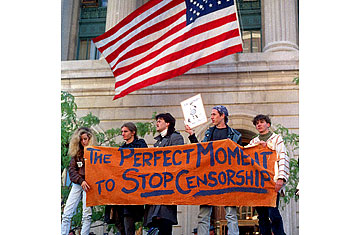
A Cincinnati protest, 1990
June 12, Washington, D.C., U.S.
The show was called "the perfect moment." it could just as well have been called "The Perfect Storm."
Twenty years ago, a traveling exhibition of photographs by Robert Mapplethorpe set off one of the fiercest episodes of America's "culture wars" — the enduring squabble over sexually explicit or sacrilegious art, leering pop music, raunchy TV comedies, radio shock jocks and every other sign of lewdness and irreverence in public life. Had he been around to see it, Mapplethorpe might have enjoyed the enormous fuss he had caused. But he had died in March 1989, at age 42, of complications from AIDS. By the time of his death, he was famous for three kinds of images: cool, rigorously conceived portraits and figure studies; sharply lit pictures of flowers; and photographs of gay S&M that left nothing to the imagination. Though he wasn't a fashion photographer, like Helmut Newton, Mapplethorpe trafficked in swank transgression. No less than his portraits and floral studies, his blunt images of rough sex — a man urinating into another man's mouth, a fist inserted just so into a man's anus — were serenely composed and luxuriously lighted. The result may not always have expressed a perfect moment but it always presented a perfect paradox: a calm Apollonian framework for wild Dionysian content. And, like the Parthenon when it served as a powder keg for the Ottoman Turks, it was only a matter of time before it exploded.
Pictures of all three kinds were in "The Perfect Moment," though the S&M material was confined to an "X" portfolio that museums displayed in age-restricted cases or galleries. The show opened without incident in Philadelphia and moved from there to Chicago. The trouble started in the weeks leading to what was planned to be a July 1 opening at the Corcoran Gallery of Art in Washington, D.C.
A Political Backlash
At the time, conservatives were already furious over Piss Christ, a photograph by Andres Serrano that showed a plastic crucifix immersed in a tank of what was said to be urine. What had them so angry was that Serrano had received a $15,000 grant from a North Carolina arts group that in turn had gotten money from the National Endowment for the Arts (NEA), the federal agency established in 1965 to subsidize artists and arts groups. In May, two Republican senators, Jesse Helms of North Carolina and Alfonse D'Amato of New York, denounced Serrano from the Senate floor, where D'Amato ripped to pieces the catalog of the show the picture had appeared in.
It wasn't long before Helms learned about the Mapplethorpe show, for which the NEA had provided $30,000 to the Philadelphia museum that had organized it. In June he sent around copies of the offending pictures to members of Congress. Soon more than 100 of them signed an angry letter to the NEA criticizing it for subsidizing a show that featured "morally repugnant materials of a sexual nature." The agency's defenders pointed to federal law that prohibited it from interfering with the content of the art it helped finance.
Although the Corcoran had gotten nothing from the NEA to subsidize its presentation of the Mapplethorpes, it received around $300,000 a year in federal funding. Concerned that a fight over the exhibit would just make things worse for the NEA — and that her museum could get caught up in the mess — the Corcoran's director, Christina Orr-Cahall, announced on June 12 that she was canceling the show. "We really felt this exhibit was at the wrong place at the wrong time," she said. "We could not and would not allow ourselves to be drawn into the [NEA funding] debate." Now it was the turn of the art world to be outraged. Important Corcoran staffers resigned in protest. A group of angry Washington, D.C., artists projected pictures by Mapplethorpe onto the exterior of the museum. In the months that followed, Corcoran membership dropped by 10%, and prominent artists including Ross Bleckner, Annette Lemieux and David Salle forbade the museum to exhibit their work. Meanwhile, the Mapplethorpe exhibition was picked up by another venue in the capital, the Washington Project for the Arts, where it was seen by nearly 50,000 people in less than a month.